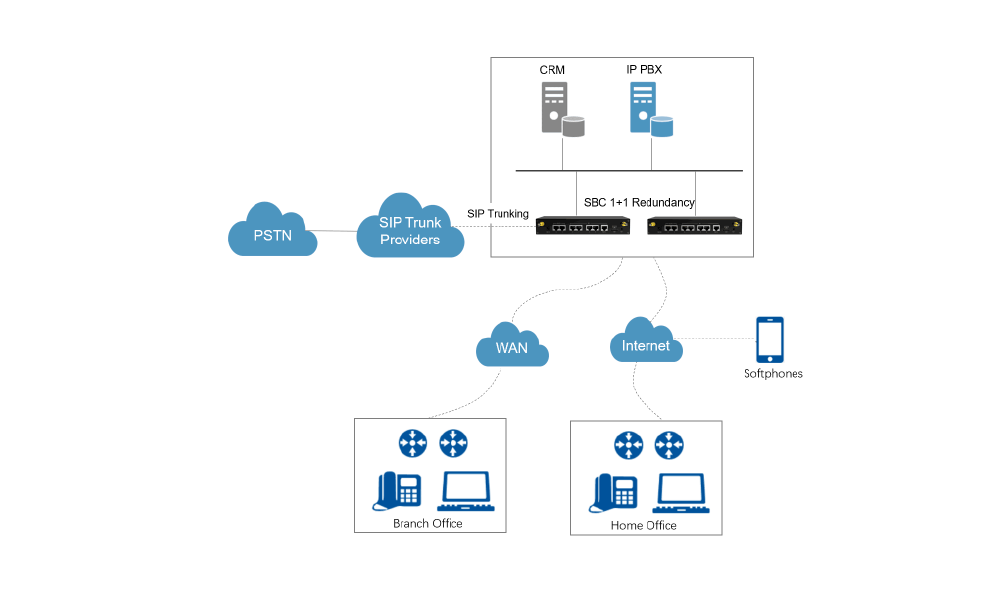Session Border Controller - An Essential Component of Remote Working
• Background
During the outbreak of COVID-19, the “social distancing” recommendations force most of employees of enterprises and organizations to work from home (WFH). Thanks to the latest technology, now it is easier for people to work from anywhere outside the traditional office environment. Obviously, it is not just a need for now, also for future, as more and more companies especially internet companies allow staffs work from home and work flexibly. How to collaborate each other from anywhere in a stable, secure and effective way?
Challenges
IP telephony system is one main way for remote offices or work-from-home users to collaborate. However, with internet connectivity, there comes several critical security issues – primary being defending again SIP scanners that try to penetrate end-customer networks.
As lots of IP telephony system vendors discovered, SIP scanners can find and begin attacking internet-connected IP-PBXs within an hour of their activation. Launched by international fraudsters, SIP scanners are constantly looking for poorly protected IP-PBX servers that they can hack and use to initiate fraudulent telephone calls. Their goal is to use the victim’s IP-PBX to initiate calls to premium-rate telephone numbers in poorly regulated nations. It is very important to protect against SIP scanner and other threads.
Also, facing the complexity of different networks and multiple SIP devices from different vendors, the connectivity issue is always a headache. It is very important to stay online and ensure remote phone users connect each other seamlessly.
CASHLY session border controller (SBC) is an excellent fit for these needs.
• What is Session Border Controller (SBC)
Session border controllers (SBCs) are situated at the edge of the enterprise network and provide secure voice and video connectivity to Session Initiation Protocol (SIP) trunk providers, users in remote branch offices, home workers/remote workers, and unified communications as a service (UCaaS) providers.
Session, from Session Initiation Protocol, refers to a real-time communication connection between endpoints or users. This is typically a voice and/or video call.
Border, refers to the interface between networks that do not have full trust of each other.
Controller, refers to the ability of the SBC to control (allow, deny, transform, end) each session that traverses the border.

• Benefits
• Connectivity
Employees working from home, or using a SIP client on their mobile phone can register through the SBC to the IP PBX, so the users can use their normal office extensions as if they were sitting in the office. SBC is providing far-end NAT traversal for the remote phones as well as enhanced security for the corporate network without the need to set up VPN tunnels. This will make the setup much easier, especially at this special time.
• Security
Network topology hiding: SBCs use network address translation (NAT) at the Open Systems Interconnection (OSI) Layer 3 Internet Protocol (IP) level and the OSI Layer 5 SIP level to keep internal network details hidden.
Voice application firewall: SBCs protect against telephony denial of service (TDoS)attacks, distributed denial of service (DDoS) attacks, fraud and theft of service, access control, and monitoring.
Encryption: SBCs encrypt the signaling and media if the traffic traverse enterprise networks and the Internet using Transport Layer Security (TLS) / Secure Real-Time Transport Protocol (SRTP).
• Resiliency
IP trunk load balancing: SBC connects to the same destination over more than one SIP trunk group to balance call loads evenly.
Alternative routing: multiple routes to the same destination over more than one SIP trunk group to overcome overload, service unavailability.
High availability: 1+1 hardware redundancy ensure your business continuity Interoperability
• Interoperability
Transcoding between various codecs and between different bitrates (for example, transcoding G.729 in enterprise network to G.711 on SIP service provider network)
SIP normalization via SIP message and header manipulation. Even you are using different vendors’ SIP terminals, there won’t be compatibility issue with the help of SBC.
• WebRTC Gateway
Connects WebRTC endpoints to non-WebRTC devices, such as calling from a WebRTC client to a phone connected through the PSTN
CASHLY SBC is an essential component which couldn’t be overlooked in remote working and work-from-home solution, ensures the connectivity, security and availability, offers a possibility to build a more stable and secure IP telephony system to help staffs collaborate even they are in different locations.
Stay connected, working at home, collaborate more efficiently.







